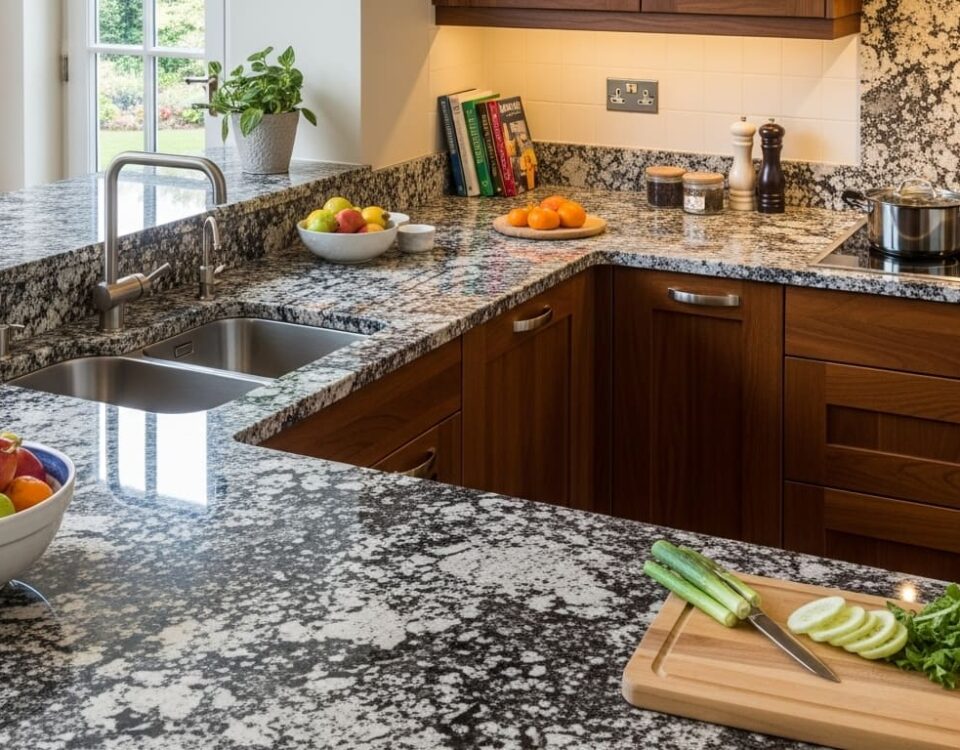Innovative Design Ideas for Porcelain Kitchen Countertops
July 15, 2024Quartz Kitchen Countertops: Colors, Patterns, and Design Ideas
July 15, 2024Soapstone Kitchen Countertops: Pros, Cons, and Care Tips
Soapstone kitchen countertops offer a unique blend of aesthetic charm and practical functionality, setting them apart in the realm of kitchen design. Known for its dense, heat-resistant properties, soapstone provides a durable surface that withstands the rigors of kitchen activities without the need for chemical sealants, making it a safe option for food preparation areas. Additionally, its tactile softness and deepening patina over time add character and warmth to any culinary space. Despite these advantages, soapstone’s susceptibility to scratches might raise concerns about its long-term appearance and maintenance requirements. Understanding how to balance these aspects is crucial for homeowners considering this material for their kitchen renovations. What specific maintenance strategies can help mitigate these concerns, and how does soapstone compare to other popular countertop materials in terms of cost and longevity?
Benefits and Drawbacks of Soapstone
Renowned for its natural beauty and durability, soapstone is an increasingly popular choice for kitchen countertops, albeit with some limitations to consider. Extracted from quarries, this natural stone is primarily composed of talc, which gives it a uniquely soft texture and contributes to its smooth, matte finish. Unlike other countertop materials, soapstone is highly resistant to heat, making it ideal for kitchens where hot pots and pans are frequently placed directly on the surface. Additionally, its density and non-porous nature mean that it does not require sealing, offering homeowners ease of mind regarding stains and bacterial growth.
However, soapstone does have its drawbacks. Its softer composition compared to materials like granite or quartz can make it susceptible to scratches and nicks. Over time, these can accumulate, affecting the countertop’s aesthetic. Furthermore, the limited range of colors—typically varying shades of gray—may not suit everyone’s design preferences.
For those who value a kitchen that reflects both functional resilience and a touch of understated elegance, soapstone can be an excellent choice. Its unique characteristics foster a sense of belonging and warmth, making any kitchen feel more like home.
Maintenance Tips for Soapstone Countertops
While soapstone countertops are durable and low-maintenance, regular care is essential to preserve their natural beauty and functionality. Being a part of a community that values quality and sustainability, you understand the importance of maintaining your soapstone surfaces to ensure they remain a central, functional piece of your kitchen’s character.
Firstly, clean your countertops regularly with mild soap and water. Avoid harsh chemicals, which can mar the soapstone’s soft surface. A soft cloth or sponge is ideal for wiping down the surface without scratching it.
Secondly, soapstone’s uniqueness lies in its ability to be enhanced with mineral oil or dry wax. This is not necessary for protection but can darken the stone to a rich, uniform charcoal color. Apply a light coat of mineral oil or wax every few months, or as desired, to achieve this effect. Over time, this process also helps in developing a natural patina that many homeowners find appealing.
Lastly, in the event of scratches or nicks, soapstone is forgiving. Minor scratches can be sanded out gently using medium-grit sandpaper, and then treated with mineral oil. This ease of repair not only ensures longevity but also adds to the kitchen countertop’s rustic charm, making it a resilient choice for families and enthusiastic cooks alike.
Read More:
Quartz Kitchen Countertops: Colors, Patterns, and Design Ideas




